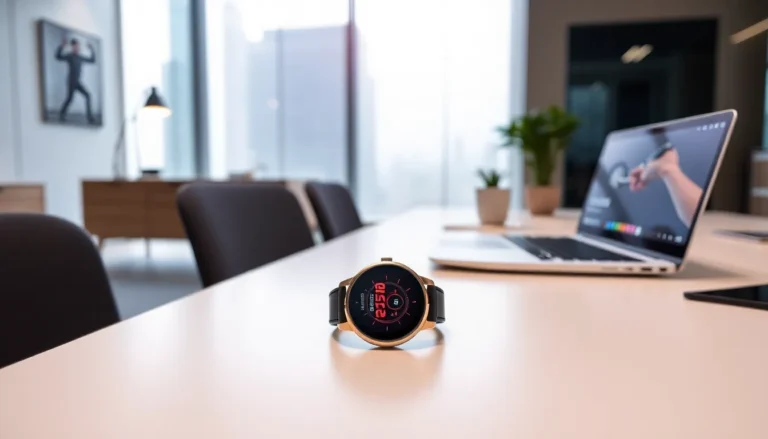Imagine strapping on a device that not only tracks your fitness but also helps you navigate through the ever-expanding digital landscape. Welcome to the world of meta wearables, where technology and connectivity intertwine to redefine our daily interactions. In an age where being connected feels more important than ever, these gadgets promise not just convenience, but a glimpse into the future. So, what’s the scoop on these intriguing devices? Let’s immerse.
Table of Contents
ToggleUnderstanding Meta Wearables

Meta wearables encompass a broad spectrum of devices designed to enhance the user experience by merging physical and digital realities. Think of wearables like smartwatches, fitness trackers, or even augmented reality glasses that elevate the ordinary into something extraordinary.
Unlike traditional wearables, meta wearables focus on creating seamless interactions with the digital world, allowing users to manage tasks and access information effortlessly. They serve as an extension of one’s self, blurring the lines between technology and daily life.
The Technology Behind Meta Wearables
At the heart of meta wearables lies a complex interplay of sensors, software, and connectivity solutions. These devices typically feature advanced sensors that track a multitude of metrics, from physical activity levels to biometric data. Many of them use Bluetooth, Wi-Fi, and even cellular networks to stay connected.
Several technologies enable the functionality of these wearables. For instance, Artificial Intelligence (AI) helps analyze user data to provide personalized recommendations, while Augmented Reality (AR) enhances user engagement by overlaying digital information onto the physical world. Through this technological synergy, meta wearables offer a more immersive experience.
Benefits of Using Meta Wearables
The advantages of utilizing meta wearables are numerous and compelling. First, these devices foster a new level of convenience in daily tasks. Imagine receiving notifications directly on your wrist or having navigation directions projected onto your glasses while walking. This immediacy not only saves time but also keeps individuals informed without breaking their stride.
Second, they promote better health and wellness tracking. Many meta wearables sync with health apps, allowing users to monitor their fitness progress and even receive alerts when things don’t look quite right. This can lead to smarter lifestyle choices and proactive health management.
Finally, a growing community of users is attracted by the social connectivity these devices help. Social sharing features enable individuals to join fitness challenges or collaborate on projects in real-time, enriching both personal interactions and professional collaborations.
Challenges and Considerations
Even though their numerous benefits, meta wearables do come with certain challenges. Privacy concerns are often at the forefront: with devices continuously collecting data, users may wonder who has access to their personal information and how it is being used.
Also, battery life remains a critical consideration. While technology is advancing, it is still common for many wearables to require frequent charging. This inconvenience can impact user satisfaction and overall experience.
Finally, there are compatibility issues: not all devices seamlessly integrate with every operating system or platform. Users might face frustrations when trying to connect various devices, leading to potential functionality limitations.
Notable Meta Wearable Devices
Several meta wearable devices stand out on the market today. One of the frontrunners is the Apple Watch, constantly evolving with features that include ECG monitoring and fitness tracking. Then there’s the Fitbit line of products, known for their emphasis on health tracking alongside social features.
In the realm of augmented reality, the Microsoft HoloLens allows users to interact with digital objects within their physical environment, making it a game-changer for industries like healthcare and engineering. Each of these devices showcases unique capabilities, emphasizing how diverse the meta wearable category can be.
The Role of Software in Meta Wearables
Software serves as the backbone of meta wearables, transforming raw data into actionable insights. User-friendly interfaces make it simpler for individuals to manage their devices, while robust operating systems paves the way for seamless app integration.
Apps play an essential role, catering to various needs, from fitness tracking to productivity enhancements. Many wearables also support third-party applications, enriching their utility through a customized experience.
As the software continues to evolve, updates can expand a device’s functionality, ensuring users remain engaged and satisfied, and maximizing the investment in their wearable.
Future Trends in Meta Wearables
Looking ahead, the future of meta wearables seems bright and full of potential. Expect advancements in biometric tracking, allowing for deeper insights into health data. Imagine wearables that can not only monitor your heart rate but also analyze blood sugar levels in real time.
Also, with the rise of 5G technology, faster and more reliable connectivity will enhance the functionalities of these devices, making them more responsive and efficient. Besides, environmental sustainability trends will see manufacturers striving to create eco-friendly wearables that also meet consumer demands for durability.
These innovations will undoubtedly shape the landscape of meta wearables and redefine user experiences.









